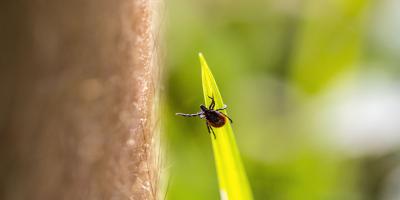Ticks: Not a Concern in the Winter, Right

Ah, wintertime -- kids get a vacation from school, you might take some time off from work, and everyone can stop worrying about warm-weather pests like ticks, right? Well, although you and your family might get a winter break, ticks don’t actually have a fully dormant season.
Tick activity is based on temperature, not season, which means they’re still a threat to you and your pets year-round, so don’t let your guard down just yet.
Ticks for All Seasons
Although peak tick season generally occurs during the warmer months, many New Englanders are surprised to discover that ticks are actually most active during October and November. They know winter is coming, and they try to stock up on meaty meals (like you) before their food sources become scarcer. But even winter itself, although it slows them down, doesn’t eliminate their threat completely.
Ticks freeze in place -- literally -- when the temperatures drop below 32-degrees Fahrenheit; but as soon as the ground thaws and the air temperatures warm above 35 degrees, they start moving again. That means that, as welcome as so-called “Indian summers” can be, they can bring with them an increase in tick activity, which is especially concerning in more rural areas where ticks generally flourish.
Take Cover Against Ticks
The threat of ticks doesn’t just come from how annoying it is to get bitten (or how difficult the little suckers are to remove once they become fully embedded). Ticks are vectors for a variety of illnesses, but most notably Lyme disease. Lyme disease is a dangerous and sometimes fatal infection that affects humans and animals.
If left untreated, Lyme disease can result in irreparable physical and neurological impairment. It only takes about 36 to 48 hours from the time a tick attaches to transmit Lyme disease to a host, meaning it’s imperative to catch tick bites early and remove the tick properly. If you live in an area where ticks abound (which basically means all of New England), there are several preventative measures you can take to avoid tick bites.
Prevent and Be Proactive
When venturing into the outdoors in weather above 35-degrees, first apply insect repellent containing DEET or permethrin. Wear light-colored clothing (which makes ticks easier to spot) and long pants tucked into your socks.
Stay on trails and designated pathways, avoiding tall grassy areas or off-trail areas with heavy underbrush. Be sure to check for ticks before settling into the house -- and always take all of these precautions for children and pets, too.
As an added safeguard, toss any clothes, blankets, towels or other linens you were using outdoors in a dryer before running them through the washing machine to kill any hitchhikers you may have brought in with you (the washer alone won’t do the job).
Finally, check everyone’s bodies (especially your pets'!) for ticks, being sure to comb through hair (with an actual comb), paying particular attention to creviced areas like armpits and between fingers and toes.
Before we approach the warmer months, take control of your yard this spring. Be in the know when it comes to keeping ticks off your turf and visit our tick control page for more information and to request a free quote.



